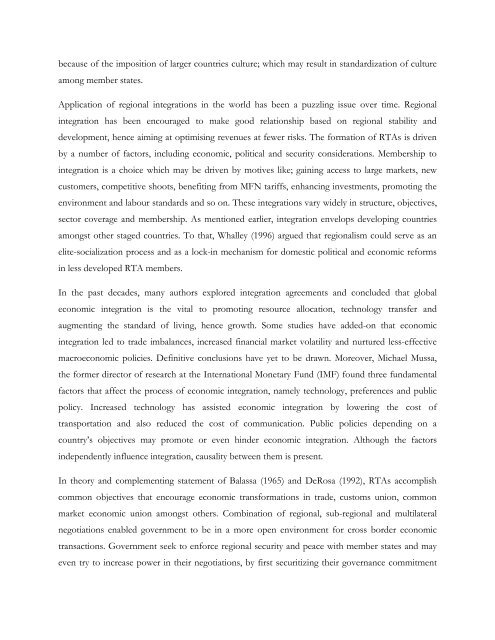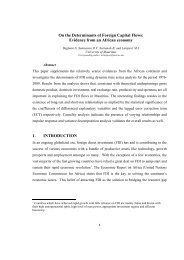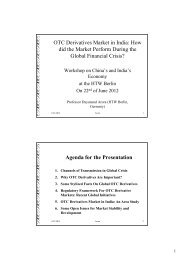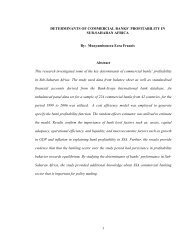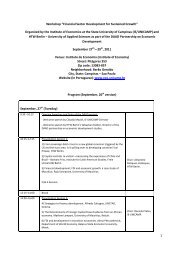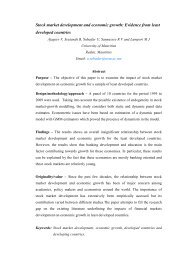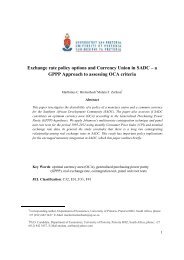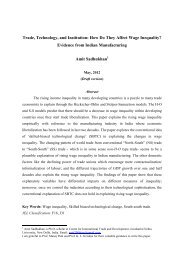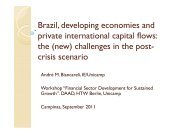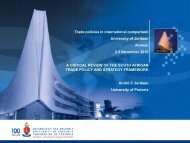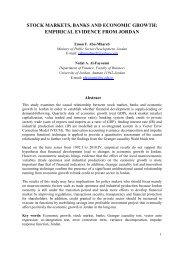RTA and Economic Growth. The case of SADC - DAAD partnership ...
RTA and Economic Growth. The case of SADC - DAAD partnership ...
RTA and Economic Growth. The case of SADC - DAAD partnership ...
Create successful ePaper yourself
Turn your PDF publications into a flip-book with our unique Google optimized e-Paper software.
ecause <strong>of</strong> the imposition <strong>of</strong> larger countries culture; which may result in st<strong>and</strong>ardization <strong>of</strong> culture<br />
among member states.<br />
Application <strong>of</strong> regional integrations in the world has been a puzzling issue over time. Regional<br />
integration has been encouraged to make good relationship based on regional stability <strong>and</strong><br />
development, hence aiming at optimising revenues at fewer risks. <strong>The</strong> formation <strong>of</strong> <strong>RTA</strong>s is driven<br />
by a number <strong>of</strong> factors, including economic, political <strong>and</strong> security considerations. Membership to<br />
integration is a choice which may be driven by motives like; gaining access to large markets, new<br />
customers, competitive shoots, benefiting from MFN tariffs, enhancing investments, promoting the<br />
environment <strong>and</strong> labour st<strong>and</strong>ards <strong>and</strong> so on. <strong>The</strong>se integrations vary widely in structure, objectives,<br />
sector coverage <strong>and</strong> membership. As mentioned earlier, integration envelops developing countries<br />
amongst other staged countries. To that, Whalley (1996) argued that regionalism could serve as an<br />
elite-socialization process <strong>and</strong> as a lock-in mechanism for domestic political <strong>and</strong> economic reforms<br />
in less developed <strong>RTA</strong> members.<br />
In the past decades, many authors explored integration agreements <strong>and</strong> concluded that global<br />
economic integration is the vital to promoting resource allocation, technology transfer <strong>and</strong><br />
augmenting the st<strong>and</strong>ard <strong>of</strong> living, hence growth. Some studies have added-on that economic<br />
integration led to trade imbalances, increased financial market volatility <strong>and</strong> nurtured less-effective<br />
macroeconomic policies. Definitive conclusions have yet to be drawn. Moreover, Michael Mussa,<br />
the former director <strong>of</strong> research at the International Monetary Fund (IMF) found three fundamental<br />
factors that affect the process <strong>of</strong> economic integration, namely technology, preferences <strong>and</strong> public<br />
policy. Increased technology has assisted economic integration by lowering the cost <strong>of</strong><br />
transportation <strong>and</strong> also reduced the cost <strong>of</strong> communication. Public policies depending on a<br />
country’s objectives may promote or even hinder economic integration. Although the factors<br />
independently influence integration, causality between them is present.<br />
In theory <strong>and</strong> complementing statement <strong>of</strong> Balassa (1965) <strong>and</strong> DeRosa (1992), <strong>RTA</strong>s accomplish<br />
common objectives that encourage economic transformations in trade, customs union, common<br />
market economic union amongst others. Combination <strong>of</strong> regional, sub-regional <strong>and</strong> multilateral<br />
negotiations enabled government to be in a more open environment for cross border economic<br />
transactions. Government seek to enforce regional security <strong>and</strong> peace with member states <strong>and</strong> may<br />
even try to increase power in their negotiations, by first securitizing their governance commitment


